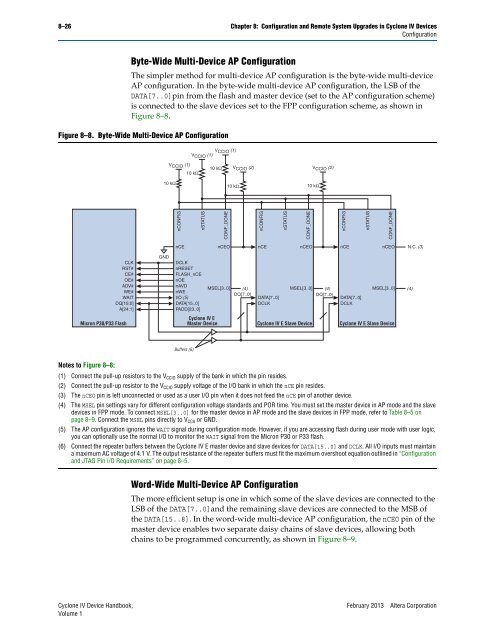Configuration and Remote System Upgrades in Cyclone IV ... - Altera
Configuration and Remote System Upgrades in Cyclone IV ... - Altera
Configuration and Remote System Upgrades in Cyclone IV ... - Altera
Create successful ePaper yourself
Turn your PDF publications into a flip-book with our unique Google optimized e-Paper software.
8–26 Chapter 8: <strong>Configuration</strong> <strong>and</strong> <strong>Remote</strong> <strong>System</strong> <strong>Upgrades</strong> <strong>in</strong> <strong>Cyclone</strong> <strong>IV</strong> Devices<br />
<strong>Configuration</strong><br />
Byte-Wide Multi-Device AP <strong>Configuration</strong><br />
The simpler method for multi-device AP configuration is the byte-wide multi-device<br />
AP configuration. In the byte-wide multi-device AP configuration, the LSB of the<br />
DATA[7..0]p<strong>in</strong> from the flash <strong>and</strong> master device (set to the AP configuration scheme)<br />
is connected to the slave devices set to the FPP configuration scheme, as shown <strong>in</strong><br />
Figure 8–8.<br />
Figure 8–8. Byte-Wide Multi-Device AP <strong>Configuration</strong><br />
Notes to Figure 8–8:<br />
CLK<br />
RST#<br />
CE#<br />
OE#<br />
ADV#<br />
WE#<br />
WAIT<br />
DQ[15:0]<br />
A[24:1]<br />
Micron P30/P33 Flash<br />
GND<br />
V CCIO (1)<br />
10 kΩ<br />
nCONFIG<br />
nCE<br />
DCLK<br />
nRESET<br />
FLASH_nCE<br />
nOE<br />
nAVD<br />
nWE<br />
I/O (5)<br />
DATA[15..0]<br />
PADD[23..0]<br />
VCCIO (1)<br />
VCCIO (1)<br />
10 kΩ<br />
Buffers (6)<br />
nSTATUS<br />
10 kΩ<br />
(1) Connect the pull-up resistors to the VCCIO supply of the bank <strong>in</strong> which the p<strong>in</strong> resides.<br />
(2) Connect the pull-up resistor to the VCCIO supply voltage of the I/O bank <strong>in</strong> which the nCE p<strong>in</strong> resides.<br />
(3) The nCEO p<strong>in</strong> is left unconnected or used as a user I/O p<strong>in</strong> when it does not feed the nCE p<strong>in</strong> of another device.<br />
(4) The MSEL p<strong>in</strong> sett<strong>in</strong>gs vary for different configuration voltage st<strong>and</strong>ards <strong>and</strong> POR time. You must set the master device <strong>in</strong> AP mode <strong>and</strong> the slave<br />
devices <strong>in</strong> FPP mode. To connect MSEL[3..0] for the master device <strong>in</strong> AP mode <strong>and</strong> the slave devices <strong>in</strong> FPP mode, refer to Table 8–5 on<br />
page 8–9. Connect the MSEL p<strong>in</strong>s directly to VCCA or GND.<br />
(5) The AP configuration ignores the WAIT signal dur<strong>in</strong>g configuration mode. However, if you are access<strong>in</strong>g flash dur<strong>in</strong>g user mode with user logic,<br />
you can optionally use the normal I/O to monitor the WAIT signal from the Micron P30 or P33 flash.<br />
(6) Connect the repeater buffers between the <strong>Cyclone</strong> <strong>IV</strong> E master device <strong>and</strong> slave devices for DATA[15..0] <strong>and</strong> DCLK. All I/O <strong>in</strong>puts must ma<strong>in</strong>ta<strong>in</strong><br />
a maximum AC voltage of 4.1 V. The output resistance of the repeater buffers must fit the maximum overshoot equation outl<strong>in</strong>ed <strong>in</strong> “<strong>Configuration</strong><br />
<strong>and</strong> JTAG P<strong>in</strong> I/O Requirements” on page 8–5.<br />
Word-Wide Multi-Device AP <strong>Configuration</strong><br />
CONF_DONE<br />
nCEO nCE<br />
nCEO<br />
nCE<br />
nCEO N.C. (3)<br />
MSEL[3..0]<br />
<strong>Cyclone</strong> <strong>IV</strong> E<br />
Master Device<br />
V CCIO (2) V CCIO (2)<br />
10 kΩ 10 kΩ<br />
(4)<br />
MSEL[3..0] (4)<br />
DQ[7..0]<br />
DATA[7..0]<br />
DCLK<br />
DQ[7..0]<br />
The more efficient setup is one <strong>in</strong> which some of the slave devices are connected to the<br />
LSB of the DATA[7..0]<strong>and</strong> the rema<strong>in</strong><strong>in</strong>g slave devices are connected to the MSB of<br />
the DATA[15..8]. In the word-wide multi-device AP configuration, the nCEO p<strong>in</strong> of the<br />
master device enables two separate daisy cha<strong>in</strong>s of slave devices, allow<strong>in</strong>g both<br />
cha<strong>in</strong>s to be programmed concurrently, as shown <strong>in</strong> Figure 8–9.<br />
<strong>Cyclone</strong> <strong>IV</strong> Device H<strong>and</strong>book, February 2013 <strong>Altera</strong> Corporation<br />
Volume 1<br />
nCONFIG<br />
nSTATUS<br />
CONF_DONE<br />
<strong>Cyclone</strong> <strong>IV</strong> E Slave Device<br />
nCONFIG<br />
DATA[7..0]<br />
DCLK<br />
nSTATUS<br />
CONF_DONE<br />
MSEL[3..0]<br />
<strong>Cyclone</strong> <strong>IV</strong> E Slave Device<br />
(4)
















